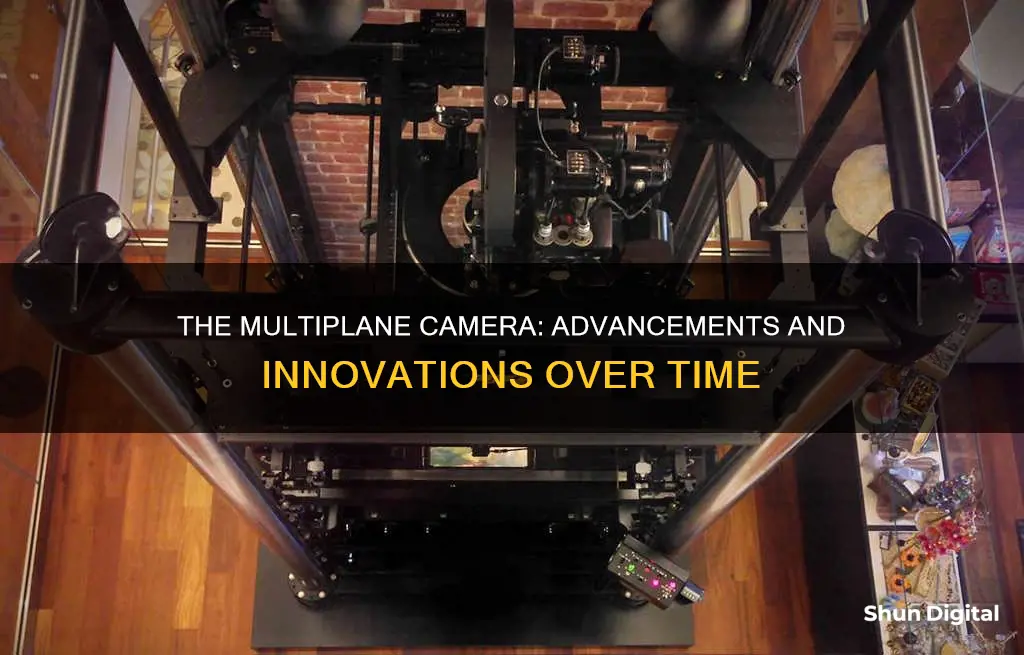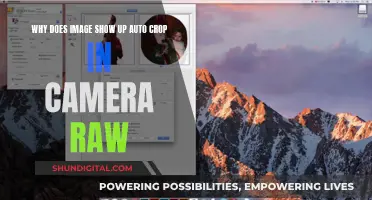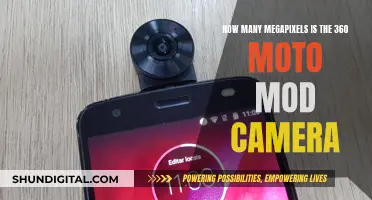
The multiplane camera is a motion-picture camera used in traditional animation to create a three-dimensional effect. While the concept of the multiplane camera was not new, with early versions created by Lotte Reiniger and Berthold Bartosch, Disney's 1937 version is often credited as the first of its kind. Disney's camera used up to seven layers of artwork, with transparent elements, to create an illusion of depth. This camera was used in many of their classic films, including Pinocchio, Fantasia, and Bambi. The Little Mermaid was the final film to use this technique before it was replaced by digital animation.
What You'll Learn
- The multiplane camera was used to create a three-dimensional effect
- It was made up of multiple layers that moved independently of each other
- The multiplane camera was first used in Walt Disney's Snow White and the Seven Dwarfs
- The final film to use the multiplane camera was The Little Mermaid
- The multiplane camera was made obsolete by digital animation

The multiplane camera was used to create a three-dimensional effect
The earliest multiplane camera was developed by Lotte Reiniger and her husband, Carl Koch, for the 1926 animated feature "The Adventures of Prince Achmed". Reiniger's design used multiple layers of glass to create depth and a fixed camera positioned above the artwork. This camera served as a prototype for later multiplane cameras, including the one created by Disney.
Disney's multiplane camera, invented in 1937 by William Garity, built upon the ideas of Reiniger and others to create an even more sophisticated and versatile tool for animation. Disney's camera used up to seven layers of artwork, with each layer containing a different element of the scene, such as the sun, a house, a fence, or a tree. These layers were made of transparent sheets or panes of glass, allowing the layers behind to be seen. The camera could also be adjusted vertically, allowing for more types of shots than its predecessors. This camera was used in Disney films such as "Pinocchio", "Fantasia", "Bambi", and "Peter Pan", and it changed the animation industry forever.
The multiplane camera was a crucial innovation in the history of animation, allowing animators to create realistic tracking shots, rotating images, and special effects. It required a team of technicians to operate and adjust the positioning, lighting, and speed for each shot. While the multiplane camera has since been replaced by digital animation techniques, it remains a testament to the creativity and ingenuity of animators and engineers in the pursuit of bringing imagination to life.
Auto Mode: Your Camera's Smart Default Setting
You may want to see also

It was made up of multiple layers that moved independently of each other
The multiplane camera is a motion-picture camera used in the traditional animation process. It was designed to move several pieces of artwork past the camera at different speeds and distances, creating a sense of parallax or depth. This effect is achieved by using multiple layers of transparent artwork, allowing other layers to be seen behind them. These layers move independently of each other, with each layer having its own speed and direction. The further away from the camera, the slower the speed, creating an illusion of depth. This technique is known as the parallax process.
The multiplane camera was a significant improvement over traditional animation methods, which struggled to create a convincing sense of depth and perspective. By using multiple layers, animators could create dynamic foreground and background images, adding depth and dimension to their animations. This technique also allowed for more complex camera movements, such as tracking shots and rotations, which would have been difficult to achieve with traditional animation methods.
The earliest multiplane camera was developed by Lotte Reiniger and her husband, Carl Koch, for the 1926 animated feature "The Adventures of Prince Achmed". Reiniger's design used multiple layers of glass to create depth in figure-ground relationships, with the camera fixed above the artwork. This design inspired later innovations, such as Ub Iwerks' multiplane camera, which used parts from an old Chevrolet automobile.
The most famous and advanced multiplane camera was developed by William Garity for Disney Studios in 1937. Disney's version featured up to seven layers of artwork, allowing for more sophisticated uses than its predecessors. Each layer was painted in oils on glass and shot under a vertical and moveable camera, creating a three-dimensional effect. Disney's multiplane camera played a pivotal role in bringing depth and complexity to classic animated films such as "Pinocchio", "Fantasia", "Bambi", and "Peter Pan".
Mastering Camera Focus: Modes for Every Scenario
You may want to see also

The multiplane camera was first used in Walt Disney's Snow White and the Seven Dwarfs
The multiplane camera was a groundbreaking technical achievement. It created depth and a sense of realism in animation, blurring the line between traditional animation and live action. The camera used several layers of artwork (painted in oils on glass) that moved at various speeds and distances from one another, creating an illusion of depth. This was done by leaving parts of the artwork layers transparent, allowing other layers to be seen behind them. The multiplane camera also allowed for new types of special effects, such as the movement of water and the flickering of stars or light.
The multiplane camera was a complex device with seven layers of artwork, each layer with its own individual movement. It was also the first multiplane camera to have a vertical setup, allowing for a wider range of shots than the previous horizontal setup. The camera was completed in early 1937 and was first tested in a Silly Symphony short called The Old Mill, which won the 1937 Academy Award for Animated Short Film.
The multiplane camera was then used extensively in Snow White and the Seven Dwarfs, where it created a sense of movement and depth in the backgrounds, as well as spinning effects in scenes such as the Evil Queen drinking her potion. The camera's use in this film changed animation forever, and it would be used in many subsequent Disney films, including Pinocchio, Cinderella, Bambi, and Sleeping Beauty.
Charging Your 4K Dual Action Camera: A Quick Guide
You may want to see also

The final film to use the multiplane camera was The Little Mermaid
The multiplane camera is a motion-picture camera used in the traditional animation process. It creates a sense of parallax or depth by moving a number of pieces of artwork past the camera at various speeds and distances. The multiplane effect is sometimes referred to as a parallax process.
The earliest multiplane camera used in animation was developed by Lotte Reiniger and her husband, Carl Koch, for her 1926 animated feature The Adventures of Prince Achmed. Reiniger had long experimented with Chinese shadow puppetry and its methods of suggesting depth by layering shallow, flat planes with colourful backgrounds and backlit action. Her novel design, dating to 1923, used multiple layers of glass to create depth in the figure-ground relationships, with the camera fixed above the artwork.
In the 1930s, animators and directors like Ub Iwerks began improving on Reiniger's design and techniques, seeking to add to the parallax illusion to create a further dimensional effect, as well as travelling shots moving through space. In 1933, Iwerks developed a more advanced multiplane design, partly from salvaged parts from an old Chevrolet automobile. His camera was used in several of the Iwerks Studio's Willie Whopper and Comicolor cartoons of the mid-1930s.
Disney is often credited with inventing the multiplane camera, but their studios did not bring multiplane technique into use until nearly 15 years after Lotte Reiniger's first films. An advanced multiplane camera was developed by William Garity for Disney Studios to be used in the production of Snow White and the Seven Dwarfs. The camera was completed in early 1937 and tested in a Silly Symphony called The Old Mill, which won the 1937 Academy Award for Animated Short Film.
Disney's multiplane camera, which used up to seven layers of artwork (painted in oils on glass) shot under a vertical and moveable camera set for successive frame Technicolor, allowed for more sophisticated uses than the Iwerks or Fleischer versions. The multiplane was featured prominently in Disney films such as Pinocchio, Fantasia, Bambi, The Adventures of Ichabod and Mr. Toad, Cinderella, Alice in Wonderland, Sleeping Beauty and The Jungle Book. The camera would be used more rarely in later movies, like The Fox and the Hound, which contains just a single multiplane shot.
The Sweet Journey: Chocolate's On-Camera Making
You may want to see also

The multiplane camera was made obsolete by digital animation
The multiplane camera was an important innovation in the history of animation, allowing animators to create a sense of depth in their work. However, its use was relatively short-lived, as it was made obsolete by digital animation.
The multiplane camera was a motion-picture camera that moved pieces of artwork past the camera at various speeds and distances, creating a parallax or three-dimensional effect. This was achieved by using multiple layers of artwork, with parts of the layers left transparent to allow other layers to be seen behind them. The further away from the camera, the slower the speed, creating an illusion of depth.
The earliest multiplane camera was developed by Lotte Reiniger and her husband, Carl Koch, for her 1926 animated feature "The Adventures of Prince Achmed." Reiniger had experimented with Chinese shadow puppetry and its methods of suggesting depth by layering shallow, flat planes. Her camera used multiple layers of glass to create depth, with the camera fixed above the artwork.
In the 1930s, animators began improving on Reiniger's design, seeking to enhance the parallax illusion and create a more dimensional effect. Ub Iwerks, an animator/director and former employee of Walt Disney Studios, developed a more advanced multiplane camera in 1933, using parts from an old Chevrolet automobile. This camera allowed for a number of images to be placed horizontally and moved toward the camera.
The most famous multiplane camera, however, was invented by William Garity for Walt Disney Studios in 1937 for the production of "Snow White and the Seven Dwarfs." Disney's camera used up to seven layers of artwork, shot under a vertical and moveable camera, allowing for more sophisticated uses than previous versions. It was used prominently in Disney films such as "Pinocchio," "Fantasia," "Bambi," and "Peter Pan."
Despite its success, the multiplane camera became obsolete with the advent of digital animation. The Computer Animation Production System (CAPS) rendered the multiplane camera unnecessary, as digital animation could easily create the illusion of depth without the need for physical layers. The Little Mermaid (1989) was the final Disney film to use a multiplane camera, with subsequent films being produced entirely digitally.
Today, animation software allows for the easy creation of layers and depth effects, making the multiplane camera a relic of the past. Digital animation has revolutionized the industry, offering new possibilities and freeing animators from the limitations of physical layers and cameras.
Uncover Camera Port's Stealth Mode: Here's Why
You may want to see also
Frequently asked questions
A multiplane camera is a motion-picture camera used in traditional animation that moves pieces of artwork past the camera at various speeds and distances, creating a three-dimensional effect.
The first multiplane camera, invented by Ub Iwerks in 1933, used four layers of flat artwork before a horizontal camera. In 1937, William Garity invented an advanced multiplane camera for Disney, which used up to seven layers of artwork and a vertical, movable camera, allowing for more sophisticated uses.
The multiplane camera created the illusion of depth by using several layers of artwork moving at different speeds. The further away from the camera, the slower the speed, creating a sense of parallax or depth.
The multiplane camera was used in several Disney films, including Pinocchio, Fantasia, Bambi, Peter Pan, Cinderella, Alice in Wonderland, Sleeping Beauty, and The Jungle Book. The Little Mermaid, released in 1989, was the last Disney film to use a multiplane camera.







